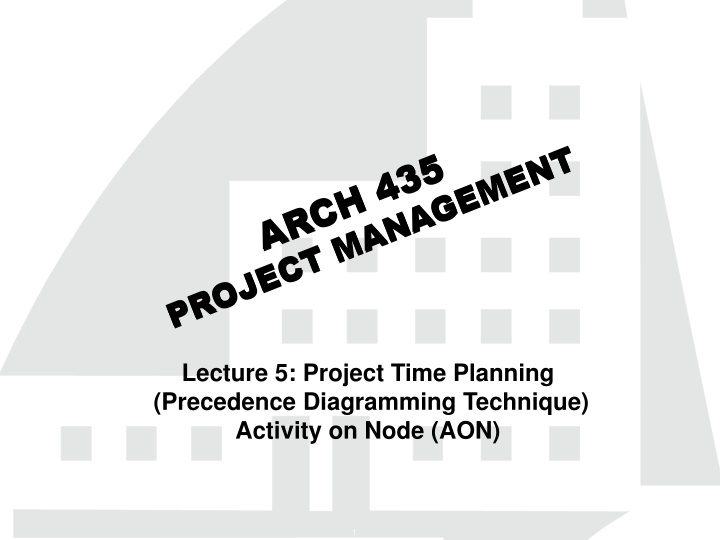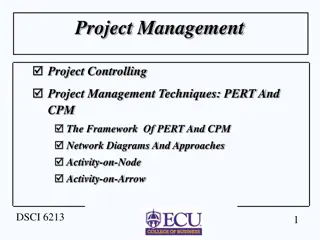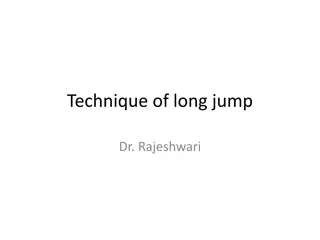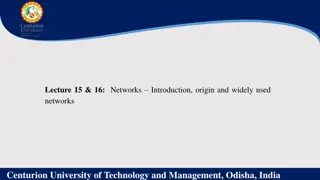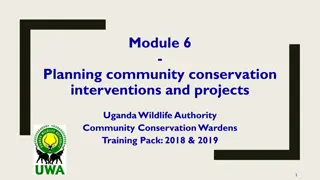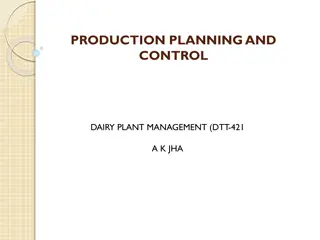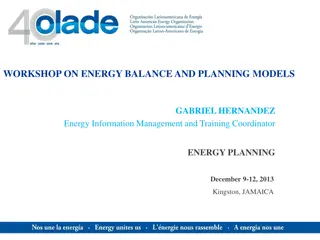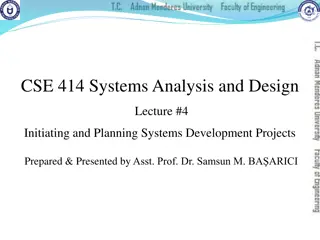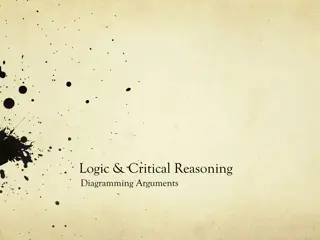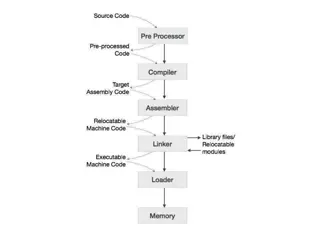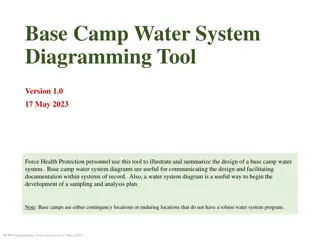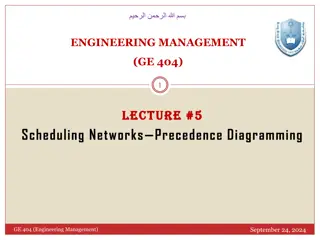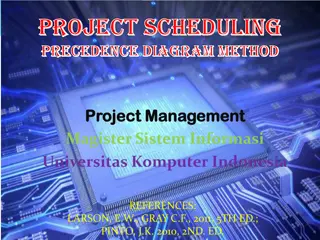Project Time Planning: Precedence Diagramming Technique (AON)
Learn about Project Time Planning using the Precedence Diagramming Technique with Activity on Node (AON). Understand the Activity on Node Notation, Activity Box, and Activity on Node Network. Explore how to create a project network and interpret the network format. An example project is provided to help you practice creating an activity on node network.
Download Presentation

Please find below an Image/Link to download the presentation.
The content on the website is provided AS IS for your information and personal use only. It may not be sold, licensed, or shared on other websites without obtaining consent from the author.If you encounter any issues during the download, it is possible that the publisher has removed the file from their server.
You are allowed to download the files provided on this website for personal or commercial use, subject to the condition that they are used lawfully. All files are the property of their respective owners.
The content on the website is provided AS IS for your information and personal use only. It may not be sold, licensed, or shared on other websites without obtaining consent from the author.
E N D
Presentation Transcript
Lecture 5: Project Time Planning (Precedence Diagramming Technique) Activity on Node (AON) Lecture 5: Project Time Planning (Precedence Diagramming Technique) Activity on Node (AON) 1
Activity on Node Notation Each time-consuming activity is portrayed by a rec rec tangular tangular figure figure. The dependencies between activities are indicated by dependency dependency lines lines (arrows) (arrows) going form one activi ty to another. Each activity activity duration duration in terms of working days is s hown in the lower, central part of the activity box. The principal advantage of the activity on node net work is that it eliminates eliminates the the need need for for dummies dummies. 2/20/2025 8: 59 AM
Activity Box Earliest Starting Date Earliest Finishing Date Activity Number Activity Description ES Code EF Description LS D LF Latest Starting Date Latest Finishing Date Duration The left side of the activity box (node) is the start si de, while the right side is the finish (end) side. 3
Activity on Node Network Each activity in the network must be preceded either by the start of the project or by the completion of a previous activity Each path through the network must be continuous gaps, discontinuities, or dangling activities. continuous with no All activities must have at least one activity following, except the activity that terminates the project. Each activity should have a unique numerical designation (activity code). Activity code is shown in the upper, central part of the activity box, with the numbering proceeding generally from project start to finish. 2/20/2025 8: 59 AM
Network Format A horizontal horizontal diagram The general developing of a network is from start to finish, from project beginning on the left to project completion on the right. The sequential relationship of one activity to another is shown by the dependency lines between them. The length of the lines between activities has no significance. Arrowheads are not always shown on the dependency lines because of the obvious left to right flow of time. Dependency lines that go backward from one activity to another (looping looping) should not be used. Crossovers Crossovers occur when one dependency line must cross over another to satisfy job logic. diagram format is the standard format. 2/20/2025 8: 59 AM
Example The activity list shown below represents the activities, the job logic and the activities durations of a small project. Draw an activity on node network to represent the project. Duration Duration (days) (days) 4 5 8 7 3 4 2 9 Activity Activity Dependency Dependency A B C E F D S R D R D R, S, A B, C None A, C A, C 6
Example A S 4 2 D E END 4 7 0 C R B F 8 9 5 3 2/20/2025 8: 59 AM
Network Computations The purpose of network computations is to determine: The overall project completion time and The time brackets within which each activity must be accomplished (Activity Times ). In activity on node network, all of the numbers associated with an activity are incorporated in the one node symbol for the activity, whereas the arrow symbols contain each activity s data in the predecessor and successor nodes, as well as on the arrow itself or in a table. ES ES Activity code Activity code EF EF Activity Description Activity Description LS LS Duration Duration LF LF 2/20/2025 8: 59 AM
EARLY ACTIVITY TIMES EARLY ACTIVITY TIMES 1. The "Early Start" (ES) or "Earliest Start" of an activity is the earliest time that the activity can possibly start allowing for the time required to complete the preceding activities. 2. The "Early Finish" (EF) or "Earliest Finish" of an activity is the earliest possible time that it can be completed. It is determined by adding that activity's duration to its early start time. 2/20/2025 8: 59 AM
COMPUTATIONS OF EARLY ACTIVITY TIMES Direction Direction: Proceed from project start to project finish, from left left to to right right. Name Name: This process is called the "forward forward pass pass". Assumption Assumption: every activity will start as early as possible. That is to say, each activity will start just as soon as the last of its predecessors is finished. The ES ES value of each activity is determined first. The EF EF time is obtained by adding the activity duration to the ES time. EF = ES + D EF = ES + D In case of merge activities the earliest possible start time is equal to the latest (or largest largest) of the EF values of the immediately preceding activities 2/20/2025 8: 59 AM
Example Example Calculate the early activity times (ES and EF) and determine project time for the previous example. A S 4 2 D E END 4 7 0 C R B F 8 9 5 3 2/20/2025 8: 59 AM
Example Example 4 8 12 14 A S 4 2 0 4 21 28 29 29 D E END 4 7 0 4 12 12 21 21 26 26 29 C R B F 8 9 5 3 2/20/2025 8: 59 AM
LATE ACTIVITY TIMES 3. The "late finish" (LF) or "Latest Finish" of an activity is the very latest that it can finish and allow the entire project to be completed by a designated time or date. 4. The late start (LS) or "Latest Start" of an activity is the latest possible time that it can be started if the project target completion date is to be met and is obtained by subtracting the activity's duration from its latest finish time. 2/20/2025 8: 59 AM
COMPUTATIONS OF LATE ACTIVITY TIMES Direction Direction: Proceed from project end to project start, from right right to to left left. Name Name: This process is called the backward backward pass pass". Assumption Assumption: Each activity finishes as late as possible without delaying project completion. The LF LF value of each activity is obtained first and is entered into the lower right portion of the activity box. The LS LS is obtained by subtracting the activity duration from the LF value. LS = LF LS = LF - - D D In case of burst activities LF value is equal to the earliest (or smallest smallest) of the LS times of the activities following. 2/20/2025 8: 59 AM
Example Example Calculate the late activity times (LS and LF) for the previous example. 4 8 12 14 A S 4 2 0 4 21 28 29 29 D E END 4 7 0 4 12 12 21 21 26 26 29 C R B F 8 9 5 3 2/20/2025 8: 59 AM
Example Example 4 8 12 14 A S 8 4 12 20 2 22 0 4 21 28 29 29 D E END 0 4 4 22 7 29 29 0 29 4 12 12 21 21 26 26 29 C R B F 4 8 12 12 9 21 21 5 26 26 3 29 2/20/2025 8: 59 AM
FLOAT Time Float or leeway is a measure of the time available for a given activity above and beyond its estimated duration. There are two common used floats: Total Total Float Float and Free Free Float Float. 2/20/2025 8: 59 AM
TOTAL FLOAT The total float of an activity is obtained by subtracting its ES time from its LS time. Subtracting the EF from the LF gives the same result. Total float (TF) = LS Total float (TF) = LS - - ES = LF ES = LF - - EF EF An activity with zero zero total float has no no spare spare time time and is, therefore, one of the operations that controls project completion time. Activities with zero total float are called critical critical activities activities . 2/20/2025 8: 59 AM
CRITICAL PATH Critical activity is quickly identified as one whose two start times at the left of the activity box are equal. Also equal are the two finish times at the right of the activity box. The critical activities must form a continuous path from project beginning to project end, this chain of critical activities is called the "critical path". The critical path is normally indicated on the diagram in some distinctive way such as with colors, heavy lines, or double lines. The critical path is the longest path in the network. Any delay in the finish date of a critical activity, for whatever reason, automatically prolongs project completion by the same amount. 2/20/2025 8: 59 AM
FREE FLOAT The free float of an activity is the amount of time by which the completion of that activity can be deferred without delaying the early start of the following activities. The free float of an activity is determined by subtracting its earliest finish time from the earliest start time of the directly following activities. FF FF = The smallest of the ES value of those activities immediately following - EF of the activity. = the smallest of the earliest start time of the successor activities minus the earliest finish time of the activity in question. FF FFi i= Min. (ES = Min. (ESj j) ) - - EF EFi i 2/20/2025 8: 59 AM
CALENDAR-DATE SCHEDULE Activity times (ES, EF, LS, LF) obtained from previous calculations are expressed in terms of expired working days working days. For purposes of project directing, monitoring and control, it is necessary to convert these times to calendar dates which each activity is expected to start and finish. calendar dates on This is done with the aid of a calendar days are numbered consecutively, starting with number 1 on the anticipated start date and skipping weekends and holidays. calendar on which the working 2/20/2025 8: 59 AM
Precedence Diagramming An important extension to the original activity-on- node concept appeared around 1964. The sole relationship used in PERT/CPM network is finish to start type of dependency, with Fsij= 0 . Precedence relationships among the activities. In Addition, one may specify a lag time associated with any of the precedence relationships, which can be used to account for overlapping times among activities. diagramming includes precedence The computation of activity times (published in 1973) is more complex than AON. 2/20/2025 8: 59 AM
Lag / Lead Times Lag / Lead Times In many cases, there is a delay between the completion of one activity and the start of another following or there is a need to show that one activity will overlap overlap another in some fashion. A successor "lags a successor. lags" a predecessor, but a predecessor "leads leads" Lag time can be designated on a dependency line with a positive, negative, or zero value. Limitations Limitations and Lag would complicate the scheduling process. Lags are not extensively used except where the time effects are substantial for special project type. and Disadvantages Disadvantages of of Lag Lag: 2/20/2025 8: 59 AM
Precedence Diagramming Relationships Precedence Diagramming Relationships 1. 1. Start Start- -to SSijis equal to the minimum number of time units that must be complete on the preceding activity (i) prior to the start of the successor (j). Lag is always applied to SS relation. to- -Start Start (SS (SSij ij) ) 2. 2. Finish Finish- -to FFijis equal to the minimum number of time units that must remain to be completed on the successor (j) after the completion of the predecessor (i). to- -Finish Finish (FF (FFij ij) ) 3. 3. Finish Finish- -to FSijis equal to the minimum number of time units that must transpire from the completion of the predecessor (i) prior to the start of the successor (j). to- -Start Start (FS (FSij ij) ) 2/20/2025 8: 59 AM
Precedence Diagramming Relationships 4. 4. Start Start- -to SFijis equal to the minimum number of time units that must transpire from the start of the predecesso r (i) to the completion of the successor (j). to- -Finish Finish (SF (SFij ij) ) 5. 5. Start Start- -to ZZijis a combination of two constraints, i.e., a start -to-start and finish-to-finish relationship. It is written with the SSijtime units first, followed by the FFijtime units. to- -Start Start and and Finish Finish- -to to- -Finish Finish (ZZ (ZZij ij) ): : 2/20/2025 8: 59 AM
